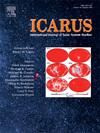Wave transmission through the megaregolith as a mechanism for lunar cold spot formation
IF 2.5
2区 物理与天体物理
Q2 ASTRONOMY & ASTROPHYSICS
引用次数: 0
Abstract
In this work we consider a lunar cold spot formation mechanism that is enabled by the granular nature of the regolith and an abrupt transition to the layer of boulders just below it (the upper megaregolith). Despite their commonplace occurrence, cold spots (regions of reduced thermal inertia surface regolith surrounding fresh craters) remain an unexplained result of the impact process. Though they represent a minimally disruptive modification of the surface (there is no sign of their existence other than a temperature signature), cold spots are observed at distances of more than 100 crater radii from the impact site. Here we propose that the long runout distances seen in cold spots (the distance over which the surface can be dilated) are enabled by impact energy decaying through meter scale subsurface boulders. Buried energy propagating radially outward would act to drive and maintain a surface dilating wave (proposed in other recent works) that uniformly reduces bulk density near to the impact site and leads to the formation of cold spot rays when large buried boulder layers are particularly well connected. We evaluate this hypothesis via simulated piston impacts into long, randomly packed 3D granular assemblies. We find that runout distance is proportional to particle size, suggesting that the meter scale boulders of the megaregolith may support long range energy propagation over cold spot scale distances. Our results suggest that the proposed cold spot generation mechanism may be a previously overlooked impact-induced gardening processes applicable to regolith covered bodies with a layered near surface structure similar to the Moon.
求助全文
约1分钟内获得全文
求助全文
来源期刊

Icarus
地学天文-天文与天体物理
CiteScore
6.30
自引率
18.80%
发文量
356
审稿时长
2-4 weeks
期刊介绍:
Icarus is devoted to the publication of original contributions in the field of Solar System studies. Manuscripts reporting the results of new research - observational, experimental, or theoretical - concerning the astronomy, geology, meteorology, physics, chemistry, biology, and other scientific aspects of our Solar System or extrasolar systems are welcome. The journal generally does not publish papers devoted exclusively to the Sun, the Earth, celestial mechanics, meteoritics, or astrophysics. Icarus does not publish papers that provide "improved" versions of Bode''s law, or other numerical relations, without a sound physical basis. Icarus does not publish meeting announcements or general notices. Reviews, historical papers, and manuscripts describing spacecraft instrumentation may be considered, but only with prior approval of the editor. An entire issue of the journal is occasionally devoted to a single subject, usually arising from a conference on the same topic. The language of publication is English. American or British usage is accepted, but not a mixture of these.
 求助内容:
求助内容: 应助结果提醒方式:
应助结果提醒方式:


